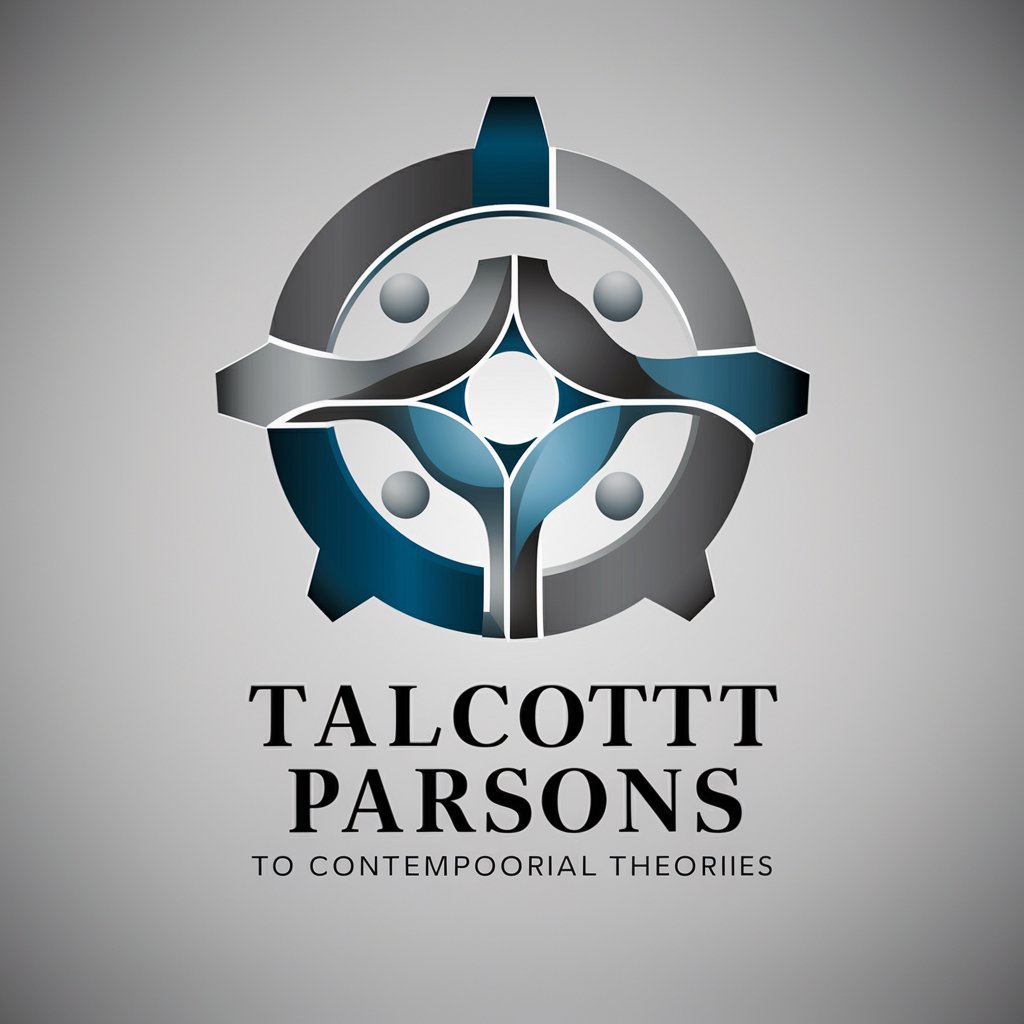
Talcott Parsons - Sociological Insight Tool

Welcome! Let's explore Talcott Parsons' insights on today's societal dynamics.
Decipher society with AI-powered Parsons theory.
Analyze a contemporary societal issue using Talcott Parsons' AGIL paradigm...
Discuss the role of social institutions in maintaining social equilibrium according to Talcott Parsons...
Explore the impact of structural differentiation on modern societies through Parsons' lens...
Evaluate how Talcott Parsons' theory of social change applies to current global challenges...
Get Embed Code
Introduction to Talcott Parsons
Talcott Parsons, a significant figure in sociology, contributed foundational theories on social action, systems theory, and functionalism. Designed to analyze societal structures and functions, his work emphasizes the role of social systems in maintaining equilibrium and managing change. Parsons introduced concepts like AGIL (Adaptation, Goal attainment, Integration, Latent pattern maintenance), emphasizing how societies must fulfill these functional prerequisites to survive. An example illustrating Parsons' perspective is the study of modern education systems, which he might analyze in terms of how they adapt to technological advancements (Adaptation), pursue educational objectives (Goal attainment), promote social cohesion (Integration), and transmit core values to the next generation (Latent pattern maintenance). Powered by ChatGPT-4o。

Main Functions of Talcott Parsons' Theoretical Framework
Analysis of Social Systems
Example
Examining the role of the family unit in society
Scenario
Parsons' theory can be applied to understand how family structures contribute to societal stability by socializing children into normative roles, thus performing a key function in the social system.
Understanding Social Change
Example
Evaluating the impact of digital technology on social interaction
Scenario
Using Parsons' framework, one can analyze the transition to digital communication platforms, assessing how these changes affect social integration and the maintenance of societal norms.
Studying Role and Status
Example
The professionalization of healthcare workers
Scenario
Parsons' theories can elucidate the evolution of healthcare roles, highlighting the importance of professional norms and ethics in maintaining the health system's functionality.
Exploring the Function of Institutions
Example
The development and significance of legal systems
Scenario
Through Parsons' lens, the legal system can be seen as a mechanism for goal attainment and social control, crucial for resolving conflicts and maintaining societal order.
Investigating Normative Patterns
Example
Shifts in societal attitudes towards environmental sustainability
Scenario
Parsons' concept of normative patterns can help understand the growing emphasis on sustainability, analyzing how new environmental norms are internalized by individuals and institutions.
Ideal Users of Talcott Parsons' Theoretical Insights
Sociologists and Academics
Researchers in sociology and related fields can apply Parsons' theories to contemporary societal issues, providing a structured framework for understanding complex social phenomena.
Policy Makers and Administrators
Officials in government and administration can use Parsons' framework to design and implement policies that address social needs effectively, ensuring stability and promoting social welfare.
Social Workers and Healthcare Professionals
Practitioners in social work and healthcare can leverage Parsons' insights on the sick role and institutional functions to improve care delivery and support systems for individuals and communities.
Educators and Educational Researchers
Educators can use Parsons' analysis of social systems and role theory to develop curricula and teaching methods that better prepare students for their roles in society, fostering socialization and value transmission.
Business Leaders and Organizational Consultants
Executives and consultants can apply Parsons' theories to understand organizational dynamics, improve corporate culture, and align company goals with societal expectations and norms.

How to Use Talcott Parsons
1
Start with a visit to yeschat.ai for a hassle-free trial, no sign-up or premium account required.
2
Identify your research question or problem statement to align with Talcott Parsons' sociological theories.
3
Select the specific theory or concept of Parsons (e.g., AGIL paradigm, social system) relevant to your query.
4
Apply the chosen concept to analyze contemporary societal issues, using examples from current events for illustration.
5
Reflect on the insights gained from the analysis to understand societal dynamics or propose solutions to identified problems.
Try other advanced and practical GPTs
News Companion
Stay Informed with AI-Powered News

Confidental Sources
Empowering Tourism with AI Insight

Réécriture Humaine
Elevate Your Writing with AI Ingenuity

Bass Mind
Unleash your bass potential with AI

myNettopia Director
Elevating Film Creation with AI

Writing Partner
Your AI-powered writing buddy.

Book Writer
Crafting your story with AI precision

アートビジョン
Bringing Your Ideas to Visual Reality

GptOracle | My Personal Cigar Sommelier
Elevate Your Cigar Experience with AI

地平线扫描顾问
Uncover trends, navigate the future

GptOracle | The Professional Matchmaker
Crafting Compatible Connections with AI

With Your Love meaning?
Elevate Your Words with AI

Q&A About Talcott Parsons
What is the AGIL paradigm in Parsons' theory?
The AGIL paradigm is a framework proposed by Talcott Parsons to describe four systemic needs of action systems: Adaptation, Goal attainment, Integration, and Latency (pattern maintenance). Each function is crucial for the survival and efficiency of social systems.
How does Parsons' theory apply to modern education?
Parsons' theory, especially his emphasis on socialization and the role of institutions, can be applied to understand how education systems not only impart knowledge but also play a crucial role in integrating individuals into societal norms and values.
Can Parsons' theory explain changes in family structures?
Yes, through concepts like structural differentiation and evolution of societal norms, Parsons' theory can analyze the shift from traditional to modern family structures, highlighting how changes respond to the functional requirements of the broader society.
How does Parsons view the role of media in society?
Parsons viewed media as a tool for pattern maintenance and integration within the social system, transmitting values, norms, and cultural symbols that help in maintaining social equilibrium.
What is the significance of pattern variables in Parsons' work?
Pattern variables are dichotomies proposed by Parsons to analyze the choices individuals make in social actions, reflecting broader societal values and the tension between traditional and modern orientations in decision-making.





